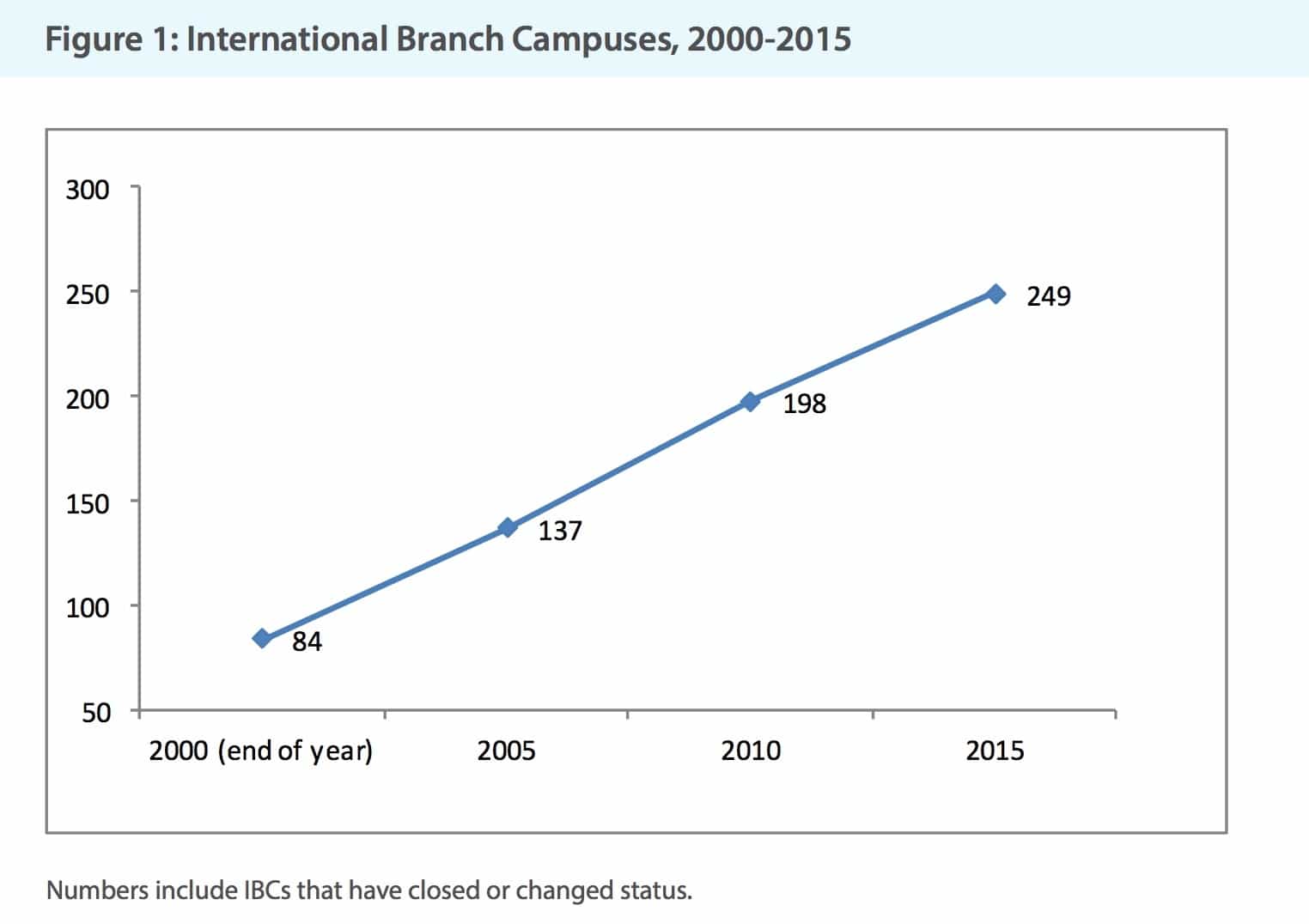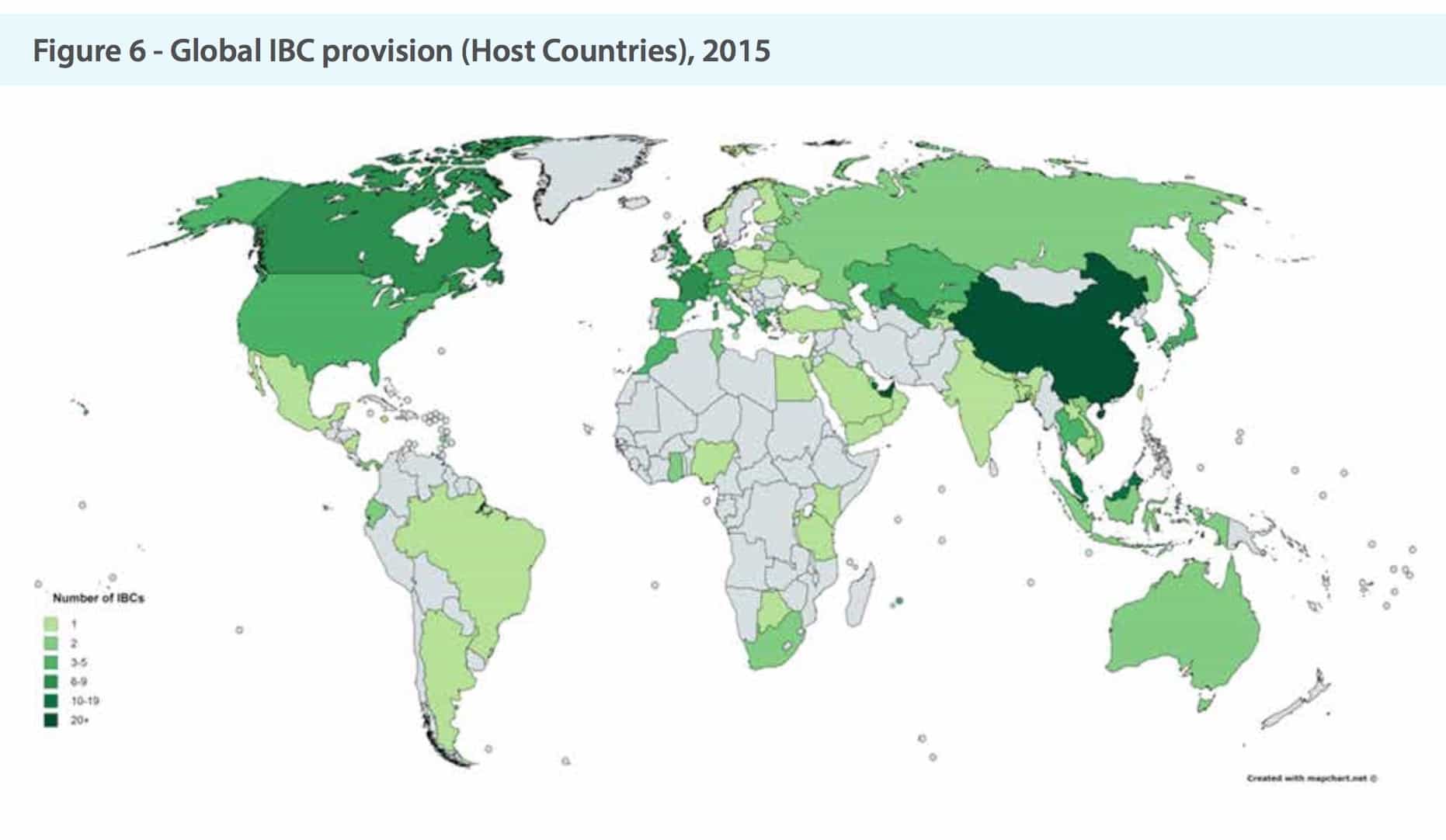Continued growth in International Branch Campuses
It’s nearly five years since the Observatory on Borderless Higher Education published its last survey on international branch campus (IBC) activity and the new report, now out, shows some significant growth and interesting developments.
This report, the fifth produced by OBHE, includes a full list and details of known IBCs in operation, those currently in development and those recently closed. IBCs are also discussed within a broader transnational education framework.
The total number of international branch campuses has grown to 249, up by a quarter since the last survey, although the rate of growth has slowed a little. However, there are about 20 branch campuses under development, so even if expansion is slower, it is undoubtedly continuing.
OBHE has a reasonably precise definition of an international branch campus:
“an entity that is owned, at least in part, by a foreign higher education provider; operated in the name of the foreign education provider; and provides an entire academic program, substantially on site, leading to a degree awarded by the foreign education provider.”

Interestingly, quite a few more countries are now involved, as host (nine new countries), as home (six new) or as both (six new countries):
New home countries include Belgium, Estonia, Japan, South Korea, Turkey and Taiwan. Since 2011, nine countries have become new hosts to IBCs: Cyprus, Egypt, Finland, Ghana, India, Malta, Nicaragua, Rwanda, and Saudi Arabia.
There is though still very little IBC activity in Africa and South America. Five home countries – United States, the United Kingdom, Russia, France and Australia – together account for nearly three quarters of all IBCs and growth and planned developments are largely from US and European universities.
The top host countries and areas of growth are perhaps unsurprising:
The top five host countries are China (32), the United Arab Emirates (31), Singapore (12), Malaysia (12), and Qatar (11), which together host 98 IBCs, or 39% of the world’s total. China has overtaken UAE as the top host country. The number of IBCs continues to increase, with concentrated growth in China, Malaysia, Mauritius and South Korea from 2011-2015 and slowed growth in UAE.

Student numbers
As the paper notes, it is far from straightforward to calculate the total number of students registered at IBCs as fewer than half of them report such data. It seems to be the larger operations which do so, and smaller or newer IBCs are the ones with missing data.
The previous OBHE survey had the following numbers:
- RMIT in Vietnam – 5,145
- Monash University in Malaysia – 5,000 (approx.)
- University of Nottingham Ningbo China – 4,536
- AMA International University in Bahrain – 3,945 (2008-09)
- University of Nottingham Malaysia Campus – 3,779
- Xi’an Jiaotong-Liverpool University – 3,240
- Curtin University in Malaysia – 3,080
- Limkokwing University of Creative Technology in Botswana – 3,040
- Wollongong in Dubai – 3,000
- Monash University in South Africa – 2,685
The top institutions by size now looks a little different but there are still seven of the previous top 10 in there:
- Xi’an Jiaotong Liverpool University – 7,000
- University of Nottingham Ningbo, China – 6,219*
- Monash University (Malaysia) – 6,000
- RMIT Vietnam – 6,000
- ESSEC Asia Pacific (Singapore) – 4,880
- University of Nottingham Malaysia Campus – 4,866*
- College of the North Atlantic – Qatar – 4,600
- Curtin University of Technology (Malaysia) – 4,411
- Beijing Normal University - Hong Kong Baptist University United International College – 4,400
- University of Wollongong in Dubai - 4,163
- Temple University – Japan campus – 4,000
- Heriot-Watt University Dubai – 3,500
- Limkokwing University of Creative Technology (UK) – 3,000
- Middlesex University – Dubai – 2,500
- Westminster International University in Tashkent – 2,400
*I’ve taken these from University of Nottingham published numbers for 2015-16 rather than the round numbers provided in the report.
It is though important to get these numbers in proportion. IBCs remain very much a niche activity in terms of transnational education:
The OBHE and C-BERT teams estimate that at the end of 2015, about 180,000 students worldwide were enrolled in IBCs as defined in this report. This is a significant number in absolute terms but is equivalent to less than 4% of the five million international students in the world- students who study in another country; and a tiny fraction of the 150 million+ higher education students globally. In a few countries, such as UAE, IBCs constitute a significant proportion of total higher education enrolment; but in most they are niche players.
Whilst the larger IBCs and the main home and host countries are not perhaps that surprising, the OBHE notes a number of interesting planned developments including by an Indian and an Iranian university:
There are speculative plans for further so-called south-to-north campuses: in September 2016, Amity University in India, purchased a Long Island branch of St. John’s University for $22 million, with plans to open its own campus on this site after it gains ownership in June 2017. Amity is also in the process of acquiring the New England Institute of Art, a for-pro t college near Boston, and one of its sister schools, the Art Institute of New York City, though the deal as not yet been approved by state o cials. Amity recently opened IBCs in Mauritius (2012) and the UAE (2011).
Additionally, Iran’s Islamic Azad University lists plans to build a branch campus in Canada, though it does not specify where, also mentioning plans to establish a physical presence in Russia, Austria, Italy, France, England, Germany, Slovakia, and some Asian and African countries. The university has had a presence in the UK since 2004 but lost its international student sponsor license after 2010, though it is still operational.
Institutions pursue branch campus developments for many different reasons but as the report points out, making money is not one of them (or if it is initially, they soon realise it is not a realistic prospect). In the case of Russia though there is undoubtedly a political dimension as the fact that with the exception of the two Russian IBCs in Dubai all of the others are in former Soviet republics: Armenia (4), Azerbaijan, Belarus (2), Kazakhstan (4), Kyrghistan (2), Latvia, Tajikistan, Ukraine and Uzbekistan (3).
And whilst the world may still view the branch of Moscow State University in Sevastopol in the Ukraine founded in 1999 with its 700 students as an IBC, since the Russian invasion of the Crimea it does have a unique status now as the first IBC to be annexed by its home country.
It will be interesting to see the continued growth of IBCs in the years ahead.















ESSEC does not have 4800 students on the Singapore campus.Their website states that “Established since 2005, ESSEC Asia-Pacific has welcomed over 5,000 students and managers”. So it’s certainly more the total number of students that came to the campus over 10 years…
It is interesting to add that the growth of IBCs in Dubai has been almost down for the last 5 years. According to Knowledge and Human Development Authorities (KHDA) website, only three were opened in 2010-2015. One of them is a Russian IBC, which is about to stop its operations facing disputes and lack of students. Amity University in Dubai is among them as well and its activities are successful, with new facilities being built just recently. The latest opening in Dubai is MODUL University in Dubai, came from Austria. It was opened a few months ago with about 100 enrolled. In total, IBCs of the last 5 years were expected to add just 1700 seats. The number is far away from Dubai’s Strategic plan for an educational hub and international students enrollments. There are a lot of reasons to be discussed, however the fact of decline is here.